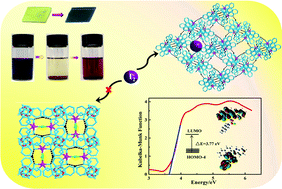Self-assembly of two supramolecular indium(iii) metal–organic frameworks for reversible iodine capture and large band gap change semiconductor behavior†
Abstract
Under self-assembly, a novel polydentate benzimidazole ligand 2-(quinoline-2-yl)-benzimidazole (2-QLBM) and two In(III) compounds, [In(2-Hqlca)2Cl3·3H2O] (1) and {[In(2-QLBM)(2-qlca)Cl2]2·CH3CN·2H2O} (2) (2-Hqlca = 2-quinolinecarboxylic acid) have been synthesized and characterized. Both the In(III) compounds are driven by noncovalent interactions to assemble into supramolecular metal–organic frameworks (MOFs). Considering 2-QLBM and 2-Hqlc ligands with different geometrical structures, compound 1 possesses a (66)-dia network with a channel diameter of about 1.856 Å, and compound 2 displays a (3,4)-connected topology network with the Schläfli symbol of (63)(65·8), whose channel diameter is about 3.683 Å. Owing to large voids in the framework, 2 can serve as a host for reversible encapsulation of iodine corresponding to the 1.52 molecules of iodine per formula unit with a fast response and high sensitivity. Upon irradiation with UV light, the two compounds display tunable fluorescence emission from blue to yellow by varying the temperature. Moreover, the absorption spectra demonstrate that the band gaps of compounds 1 and 2 are 3.71 and 3.58 eV, respectively. When adsorbing iodine into the framework, the host structure of 2 is relatively perturbed by the presence of guests and exerts a remarkable influence on the band size and gap state.

- This article is part of the themed collection: HOT articles in Inorganic Chemistry Frontiers for 2016

 Please wait while we load your content...
Please wait while we load your content...